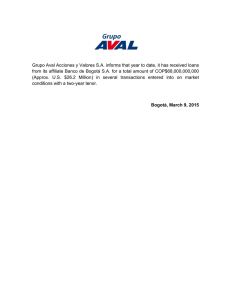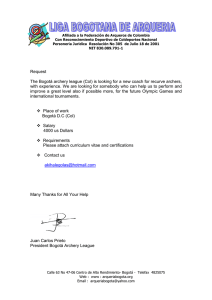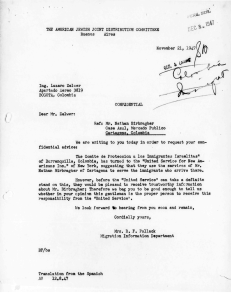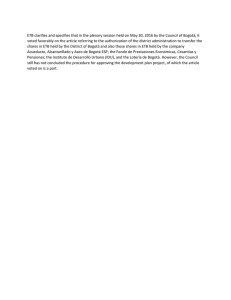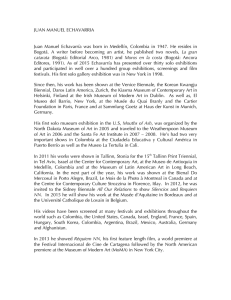Models of High Society Women in Colombia
Anuncio
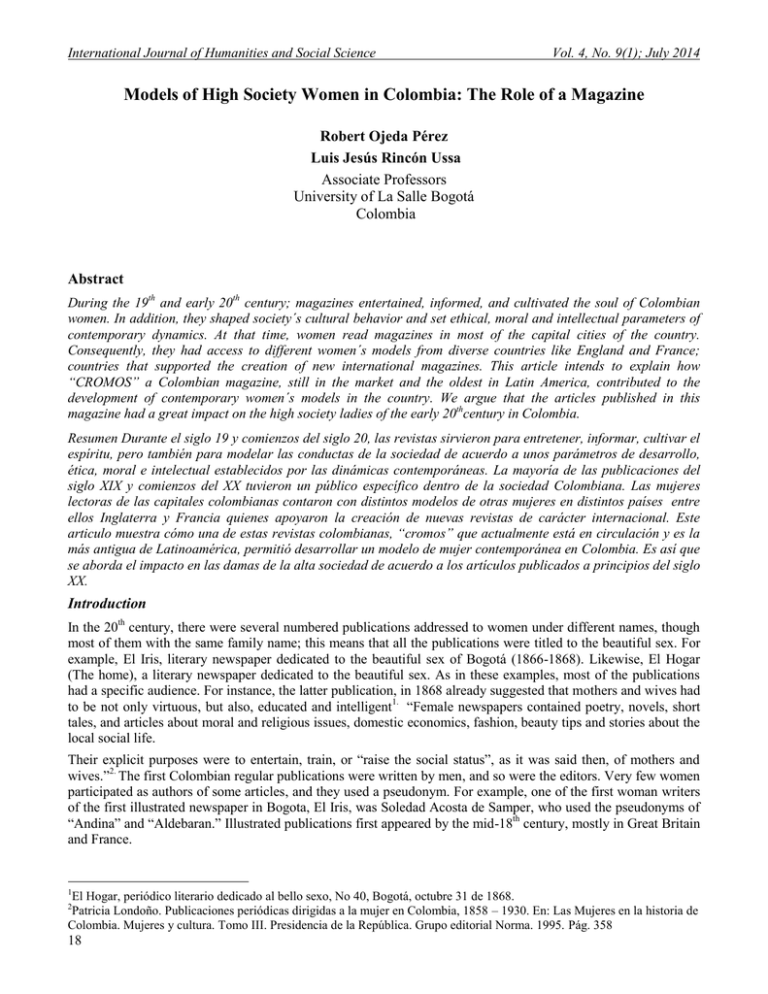
International Journal of Humanities and Social Science Vol. 4, No. 9(1); July 2014 Models of High Society Women in Colombia: The Role of a Magazine Robert Ojeda Pérez Luis Jesús Rincón Ussa Associate Professors University of La Salle Bogotá Colombia Abstract During the 19th and early 20th century; magazines entertained, informed, and cultivated the soul of Colombian women. In addition, they shaped society´s cultural behavior and set ethical, moral and intellectual parameters of contemporary dynamics. At that time, women read magazines in most of the capital cities of the country. Consequently, they had access to different women´s models from diverse countries like England and France; countries that supported the creation of new international magazines. This article intends to explain how “CROMOS” a Colombian magazine, still in the market and the oldest in Latin America, contributed to the development of contemporary women´s models in the country. We argue that the articles published in this magazine had a great impact on the high society ladies of the early 20thcentury in Colombia. Resumen Durante el siglo 19 y comienzos del siglo 20, las revistas sirvieron para entretener, informar, cultivar el espíritu, pero también para modelar las conductas de la sociedad de acuerdo a unos parámetros de desarrollo, ética, moral e intelectual establecidos por las dinámicas contemporáneas. La mayoría de las publicaciones del siglo XIX y comienzos del XX tuvieron un público específico dentro de la sociedad Colombiana. Las mujeres lectoras de las capitales colombianas contaron con distintos modelos de otras mujeres en distintos países entre ellos Inglaterra y Francia quienes apoyaron la creación de nuevas revistas de carácter internacional. Este articulo muestra cómo una de estas revistas colombianas, “cromos” que actualmente está en circulación y es la más antigua de Latinoamérica, permitió desarrollar un modelo de mujer contemporánea en Colombia. Es así que se aborda el impacto en las damas de la alta sociedad de acuerdo a los artículos publicados a principios del siglo XX. Introduction In the 20th century, there were several numbered publications addressed to women under different names, though most of them with the same family name; this means that all the publications were titled to the beautiful sex. For example, El Iris, literary newspaper dedicated to the beautiful sex of Bogotá (1866-1868). Likewise, El Hogar (The home), a literary newspaper dedicated to the beautiful sex. As in these examples, most of the publications had a specific audience. For instance, the latter publication, in 1868 already suggested that mothers and wives had to be not only virtuous, but also, educated and intelligent1. “Female newspapers contained poetry, novels, short tales, and articles about moral and religious issues, domestic economics, fashion, beauty tips and stories about the local social life. Their explicit purposes were to entertain, train, or “raise the social status”, as it was said then, of mothers and wives.”2. The first Colombian regular publications were written by men, and so were the editors. Very few women participated as authors of some articles, and they used a pseudonym. For example, one of the first woman writers of the first illustrated newspaper in Bogota, El Iris, was Soledad Acosta de Samper, who used the pseudonyms of “Andina” and “Aldebaran.” Illustrated publications first appeared by the mid-18th century, mostly in Great Britain and France. 1 El Hogar, periódico literario dedicado al bello sexo, No 40, Bogotá, octubre 31 de 1868. Patricia Londoño. Publicaciones periódicas dirigidas a la mujer en Colombia, 1858 – 1930. En: Las Mujeres en la historia de Colombia. Mujeres y cultura. Tomo III. Presidencia de la República. Grupo editorial Norma. 1995. Pág. 358 2 18 © Center for Promoting Ideas, USA www.ijhssnet.com In America, these arts were developed during the 19th century due to press freedom dynamics and the development of knowledge and qualified workers. In the case of Colombia, and in contrast to what happened in other countries in Latin America, publications addressed to women were abundant. In this sense Patricia Londoño stated that “the first [publications] appeared in the decade of the 1850s, but increased mostly between the 1870s and 1890s, and later on in the 1920s up to the mid-century. The amount of new titles is the thermometer that registered the fluctuations of women attention during these years in the country”3 In Colombia, in the course of the 19th century and the early 20th, regular publications’ main objective was to “civilize” the society, as the Colombian poet Rafael Pombo did in his different poems and fables which were published using pseudonyms in newspapers. He wanted children stopped being dirty, sloppy and barefoot. This construction of nationality was partly framed and labeled as cultural scenarios in which symbols had the role of establishing power relationships in different amounts and levels. That is why many publications sought to change Colombian living traditions, in particular those of women who were considered the agents of cultural change. To illustrate, some past traditions were ridiculed; habits like chewing tobacco in the street, wear rope-soled sandals, or being barefoot; attend cock fights, billiard rooms and have any kind of debauchery behaviors. The 19th century was a time in which this country “changed its name many times: Gran Colombia, República de la Nueva Granada, Confederación Granadina, Estados Unidos de Colombia, República de Colombia. In a way, the country defined its personality; affirmed its gestures and sociocultural identity. Particularly in the second half of this century, there were many attempts of configuring the concept of nationality in all sort of spheres: The federal government was installed with the purpose of preserving the centralism, the liberal and conservative political parties were organized, there were military overthrows of government, national constitutions, literary associations, newspapers and magazines were created; national institutions were founded as well as language and history academies; The Jockey and Gun Club appeared; maps were made, the landscape was drawn, indigenous ruins were studied, rivers were explored, the borders were defined; schools and universities were opened, educational programs were created, libraries and bookstores were installed. All these dynamics strengthened and consolidated giving way to what is called national identity. “44 Along these lines, the numbered publications of the late 19th and early 20th centuries had the intention of presenting some of the parameters of the European high social classes to young Colombian ladies. These cultural behaviors covered issues like: good manners, feeding the intellect and spirit, practice of appropriate sports for women; and above all, to develop refined, civilized behaviors and habits. This was a sort of national cultural endeavor, which aimed at presenting and covering all the related fields of action about women. “Great attention was given to topics that had to do with [women]. They published articles about the history of woman in human civilization, galleries of remarkable world women were created, articles to promote moral and religious education of women, and commentaries about the situation of the contemporary women. These newspapers were conceived - the subtitles indicate so - as readings for women, home, and family. That´s why there were some sections with practical recommendations and tips about domestic economy, child care, hygiene, cooking recipes, and some possible home-industries. 5 The first magazines edited in Bogota, the capital city of Colombia, were run by the writer Soledad Acosta de Samper. In 1879 she edited the magazine Mujer (woman), “readings for the family”, this fortnightly magazine was written exclusively for older and young ladies until 1881. After that, it was founded “readings for home”, a monthly magazine published for one year. “Both magazines were devoted to published biographies, historical short stories, novels about cultural customs, and articles about women.”6 In 1889 the “El Domingo de la Familia Cristiana (The Sunday of the Christian Family) was created. 3 Patricia Londoño. Publicaciones periódicas dirigidas a la mujer en Colombia, 1858 – 1930. En: Las Mujeres en la historia de Colombia. Mujeres y cultura. Tomo III. Presidencia de la República. Grupo editorial Norma. 1995. Pág. 360 4 Ojeda Pérez Robert. Recuperación histórica de la obra poética de Rafael Pombo. En: Revista el Astrolabio. Nov 2005. http://astrolabio.phipages.com/storage/.instance_9166/ASTROLABIO_BG_5-1_ART_03.pdf 5 Patricia Londoño. Publicaciones periódicas dirigidas a la mujer en Colombia, 1858 – 1930. En: Las Mujeres en la historia de Colombia. Mujeres y cultura. Tomo III. Presidencia de la República. Grupo editorial Norma. 1995. Pág. 366 6 Patricia Londoño. Publicaciones periódicas dirigidas a la mujer en Colombia, 1858 – 1930. En: Las Mujeres en la historia de Colombia. Mujeres y cultura. Tomo III. Presidencia de la República. Grupo editorial Norma. 1995. Pág. 366 19 International Journal of Humanities and Social Science Vol. 4, No. 9(1); July 2014 This was a weekly magazine which contained explanations of the Sunday’s gospels, biographies of saints, beauty queens and remarkable women. All of them were presented as models to be followed and imitated by the readers interested in the good literary customs. Besides this, some of the articles published in the magazine had to do with issues like: the good practices of children upbringing, and the good womanly ways. By the end of the 19th century, Soledad Acosta published a weekly magazine titled El Domingo (The Sunday), this magazine was devoted to publish stories, biographies, trips, science topics and literature for women. At the beginning of the 20th century, in 1905, she created the monthly magazine titled “Lecturas para el hogar” (Readings for home) which she edited entirely. This way, magazines edited by women and for women started in the 19th century. They had specific purposes like highlighting women’s beauty, their human essence, literary and cultural qualities. In Colombia, the magazines published during the dawn of the 20th century had a modern perspective. One of them was “The magazine of the ladies, run by Elisa Cano de Restrepo e Ines Arteaga de Otero, published in Bogotá, in 1907. This magazine covered issues concerning woman´s education and her inclusion in the professional fields of work; the feminine parameters in the new century regarding feminine behavior and the duties not only at home, but also, about how they could contribute to the family´s income by carrying out paid jobs. “The implementation of capitalism in Colombia demanded government policies oriented towards the formation of individuals that had the disposition of consuming. The inclusion of people in the world of work had to do with government mechanisms such as publicity, fashion and entertainment, because through them people started to identify themselves with capitalist life styles” 7 Two magazines that assumed a much more modern perspective regarding design, and the proposals of women´s models were the monthly magazine Femeninas (Females) and Cromos. Both were created in 1916. The first was produced by women only. They sought to educate women about how they should behave in the modern world, due to that, most of them studied in colleges and universities. For instance, The Escuela Normal Superior of Medellin and even one of them studied in London. It is worth mentioning that these magazines were edited and founded in Pereira, an intermediate city in the development process of Colombia. This magazine was important because it was published using an appropriate language for all audiences, this perspective was taken place in another parts of the world such as the United Kingdom and Europe. The magazines encouraged the female readers to integrate the practice of gymnasia, learning sciences, mathematics, suggestions about home economy, sewing and cooking. By contrast, the weekly magazine, Cromos, was produced by different people, among them: poets, writers, artists, readers and advertisers of diverse topics; nonetheless, the females section was mostly written by men as it was explained in the first editorial of the magazine, the reason for this was that the magazine wanted to be a publication of use for men, so that they could talk about diverse issues including women: Weekly magazine with the format of the magazines in the main cities in Europe and America. A publication that registered the literary, scientific, artistic, social and political events and trends of the country, it also documents the relevant happenings of the world, issues that are the topics of passionate discussions and divergent arguments among men, always making sure that the art and good taste characterized all of the magazine´s pages8 Given that this is one of the oldest magazines in Latin America, still in the market nowadays, and about to turn 100 years, it is taken as our source of information to study the women´s models imposed in the Colombian society. Theoretical Framework When we speak of identity we refer to a concept built from a narrative perspective (Holy Baba, Paul Ricour, Hanna Arendt). 7 Santiago Castro Gómez. Tejidos Oníricos. Movilidad, capitalismo y biopolítica en Bogotá. (1910 -1930).Universidad Javeriana. Bogotá. 2009. Pág. 193. 8 Revista Cromos No 1 Enero 15 de 1916. 20 © Center for Promoting Ideas, USA www.ijhssnet.com To speak about identity from the cultural view it is essential to tackle history not as past, but it is crucial to pose questions in the cracks, in the gaps and the thresholds located between the relationship past-present. It is there, where the memory keys reside. We might understand identity as the displacement of the boundaries of difference; this means that identity is born from the contradiction between a discourse, a model and its perception in particular circumstances and a given context. In this way, difference legitimized as well as the discourses that do so. Thus, it is important not only to focus on the historical events, but in the negation level of whom receives and brings about the discourse. It is among the relationships where it is possible to establish identity elements, because it is there where the clashes of cultural differences can be evidenced as well as the flow of cultural experiences. The idea of identity is useful to rethink solidarity too, for example, gender solidarity. It is also useful to ponder about the idea of kindness (Martha Nussbaum). Identity is negotiated and fought, but it is conceived in a narrative process, because the purpose is the achievement of consensus, and identity definition is reached. Identity, according to Nietzsche, is not achieved but just named, it appears in the world of language, and every language is figurative. Therefore, there are not facts, just interpretations. This means that the construction of – me - as entity is an interpretation. For Nietzsche, there are not truths, but different ways of naming the world. Truth remains in forgetfulness. Identity is an internal experience with external causality, it´s a game of forces in which interpretations take part. Consequently, to speak about woman´s issues, it might be fictional because this idea has to do with ideals, dreams, and it is there where an image of truth or fiction is constructed. According to Nietzsche assertions about woman can be fictionalized each time she dresses up, makes-up, or assumes different roles: Woman, Mother, worker, wife, lover, girlfriend, or manager. This is why this article asks about the fictional narratives used to foster woman´s identity in the early 20th century. This way it is sought to track down the discourses that reclaim the woman´s essence instead of making it odd. The risk of the analysis of discourses is that these ones, beyond being narratives with meaning and interests, seek to establish a hegemonic model, making the discourse odd, present and image, or simply configure what the woman entails. For example, is it possible to speak about the notion of body from the perspective of identity? Worldwide Cultural Changes Identity is a Latin concept (indentitas) whose definition is relation. This implies a tension between two or more elements. Identity is a characteristic that defines something unique in the human species - I Am - It is due to that the identity concept poses challenges for its definition. For Foucault, identity is statements, for example, I am a woman. These roles, due to consumerism and the new persuasion techniques aiming at defining new individual models by means of publicity and mass media which created new values and social norms particularly address to women, who were rapidly integrated to consumerism through publicity, magazines and newspapers. “Publicity is then, a technology that seeks to change the ways of feeling and thus defining the ways of living” 9 In the early 20th century, in different countries like France, England, Germany, and in particular the United States, industrialization put new energy into the different social structures. Mass media and new technologies gave way to consumerism and the swap of values associated with agricultural life of self-fulfillment by new values related with urban bourgeois life styles associated with the economy of production, intellectuality, and communication. Societies changed rapidly according to the economical dynamics dictated by capitalism; imposing goods, commodities and service markets to the population. Therefore, industrialization generated a change in the production, and distribution ways by means of the new machines, as well as incorporated a new element in the society; Consumerism. This concept was internalized by people thanks to symbolic idea, which presented the development and the representations of the different human practices, particularly the one of woman. In this manner, in the different countries in the world, “is born a new economic principle that allows the individual to become part of - without restrictions impose by the catholic religion when prohibited sensuality - to the new consumerism logics, centered on the ownership of material things. 9 Santiago Castro Gómez. Tejidos Oníricos. Movilidad, Capitalismo y Biopolítica en Bogotá. (1910 -1930).Universidad Javeriana. Bogotá. 2009. Pág. 197. 21 International Journal of Humanities and Social Science Vol. 4, No. 9(1); July 2014 In this scenario, publicity as a technology oriented towards forming the passions and appetites of the person is a technology that inscribes the logic of capitalism in the sensibility of the human being, and thus it holds a fundamental aesthetic dimension”10. This way, the new market dynamics and consumerism rationalities are imposed in the society affecting the person´s identity. In the book number 4 of the metaphysics of Aristotle “the being is said in many different ways” the person is known because there are ways of being; the being is what is predicated or said of it. For instance, I am a woman. Identity according to Aristotle should be understood as the certainty of oneself, but at the same time his negation when it is stated several ways of being. “The virtuous Colombian woman”. As Paul Ricoeur stated, “I define myself by the other”. That´s why Hegel mentioned that persons are always different, and have a harmonic change as the beginning persistency, and in the permanent tension dwell war and agreement. For Wittgenstein, when something is stated right away the opposite is denied. That is to say that “the virtuous woman” implies good values and moral standards, but denies the opposite, or reveals the woman with bad manners and low moral standards. In the moral messages published in magazines, many times, the impact of these messages were not considered. According to Aristotle, the moral statements are legitimized by practice. If identity is what makes me different from the others, but the human being is a social entity, hence, identity implies otherness and an acknowledged option. Assertions about how women should resemble European women helped to define a behavior and practice model. For instance: Women are the spitting image of the U.K. women. Therefore they followed the queens’ ways. Fashion in Bogotá Doctor Mirabel, a Cromos reporter, tells in one of his stories, how a foreign visitor (Mr. William) was impressed by the sad looks of the people in Bogotá who were always dressed in black. “Why do we dress in black as if even the house´s cat had passed away?” asked the angry journalist, why do our outfits are obscure and monotonous? Why do we look like overwhelmed by a great grief? (Cromos 17, May 13th, 1916, 260) Journalists started to question the dressing ways of the Colombian society particularly those of the capital city, Bogotá. They compared dressing styles of cities like Paris. The taste, and new trends in the use of materials, fashion and industry, as a result they started to criticize the non-modern styles of the people in Bogota, compare with the new Parisian woman models who visited cafes, boulevards, and arcades with new styles inspired by the new tendencies of the fashion industry. They also began to question the fact that tailors were not used as they were in Paris. “Parisian tailors are great to make us change our taste overnight, and the beautiful women of Paris are marvelous to imprint a beauty mark on everything. Their flirting extravagancies and adorable ways go worldwide as the sacred laws of feminine aesthetic. (Cromos 63, abr, 28 de 1917, 225). Consequently, in Bogotá passages and fashion are imitated. In the commercial passages it was possible to find in the showcases dresses copied from the fashion magazines of Paris, and made by local tailors who found a new way of making a living. In magazines and newspapers started to appear advertisements of clothing stores that offered the latest fashion item coming from Paris. As an example, The Almacenes Plata de la Calle Real (Plata de la Calle Real Stores) bragged about the fact that they had received the latest creations from Paris. “when [in Paris] those creations are just put in the market and start being illustrated in magazines and catalogues” (Cromos 219, Jul. 24 de 1920) As a result, in Bogotá commercial passages are created, for instance; El pasaje Hernández y el pasaje Rivas, both fashion centers that little by little turned into centers for other uses. In the magazine´s advertisement section it was mentioned that: “in Europe, Cromos has an office exclusively dedicated to send pictures of the most interesting social events, the popular people in the fields of arts, science and literature” at the same time recommended that men should buy the magazine to their wives and daughters. “Don´t forget that Cromos is a recommended reading for your wives and daughters” (Cromos No. 22) Many of the magazine’s editions that started to appeared in Colombia followed the French and English formats, great emphasis was put on queens to the point that the magazine established, afterwards, the follow up of the world beauty contest, then the national one. 10 Santiago Castro Gómez. Tejidos Oníricos. Movilidad, Capitalismo y Biopolítica en Bogotá. (1910 -1930).Universidad Javeriana. Bogotá. 2009. Pág. 194. 22 © Center for Promoting Ideas, USA www.ijhssnet.com The first published magazine wrote about the Italian queen (Cromos Vol I, No. 1). The magazine described the life and habits of the queen; Italian queen, daughter of king Montenegro Nicolas I. it was highlighted that “without any doubt, she was the most remarkable feminine figure of the European royal families”. A description enriched with adjectives that portrayed a woman that went from being righteous to someone who took part in political issues to the point that in the cover page of the magazine number 25, many of the phrases that were shouted in military and political national disputes were expressed by women. Example from England. “no se toman a Zamora en una hora” (They don´t take Zomora in an hour) (See cover page No 25 Vol II 1916) Later, magazine´s editions taught women how to take care of their bodies through new sports; tennis was presented as a very popular game all around the world, a game that the aristocratic classes of Colombia could not deprived of. Specific terms used in the sport were written; court, set, net, although it was not understood how 4 people run after a ball “4 people run after a ball which is very hard to get, yelling English words” (Cromos 143) Even later magazine´s editions pointed that other sports existed such as golf and skating, the most important was footing. It was stated as a warning to women that footing “is a sport and that it was convenient to be a lady!!” further on it was remarked that: “sports harden the muscles, soften the joints and prevent overweight. It is true that ruins skin (understand the real sport is practiced outdoors and all the time: golf, tennis and Hokey). With this, the ladies were invited to leave their houses, take fresh air, and start walking; looking for the different products that were beginning to be imported and produced which could be purchased in some shops in the city. Among the many advices given to the high class ladies and young women, there was a section titled “advices for the ladies” it was common to find advices about ways in which the ladies could make themselves outstand and set apart from other social strata. It was also advisable no to lose the social perspective. For example, in a comment develop from the behavior of the United States of American first Lady titled “in the white house” it is mentioned that in Washington´s society a new trend is being established by Mrs. Wilson, “who after returning from her honey moon trip, gave a big party in response to the gossiping about the humbleness and modest weeding ceremony” she shook hands with each of the 4226 guests, this took her 3 hours and fifteen minutes. What did the editors seek with this kind of reports? Conclusions The first Colombian magazines for women wanted, on the one hand to integrate them with the production dynamics and the world of work, and on the other hand to make them part of consumerism, a glamorous life style and etiquette. In this way the fashion industry creates new identity notions in women. Cromos magazine, since the first editions, wanted to show a contemporary woman´s model based on the European life style, particularly the Parisian and British ones. They worried about the development of a woman´s model based mostly on the queens, aristocracy, and high society ladies; to achieve this propose the magazine reported about the trends, the social customs and some beauty recommendations that could be used by the female audience. In the second stage of the Cromos magazine it can be observed that many of these models and life styles have been accepted and adopted, particularly those coming from Paris and London. One of the hypotheses is that, since there were not local royal families to follow and appreciate, many cities and regions established the beauty contests, as an instrument that contributed to make the regions known. Another remarkable emerging issue is the role of a magazine in integrating women to the production system, industry and consumerism trends using the models and other woman´s narratives. 23 International Journal of Humanities and Social Science Vol. 4, No. 9(1); July 2014 Bibliography and References Anita Cañizares. Revistas feministas en Colombia: De Brujas a Vamos mujer. Pensar en Género. Teoría y práctica para nuevas cartografías del cuerpo. Instituto Pensar. Universidad Javeriana. 2004. Bogotá Colombia. Pág. 154. Balance de la consejería presidencial para la equidad de la mujer.2007 www.presidencia.gov.co Caputto silva, Luz Amparo. Revista Educación y Desarrollo Social - Bogotá, D.C., Colombia - Volumen II - No. 1 - Enero - Junio de 2008. Caputto silva, Luz Amparo. Revista Educación y Desarrollo Social - Bogotá, D.C., Colombia - Volumen II - No. 1 - Enero - Junio de 2008. Caputto silva, Luz Amparo. Revista Educación y Desarrollo Social - Bogotá, D.C., Colombia - Volumen II - No. 1 - Enero - Junio de 2008. Castro Gómez, Santiago. Tejidos Oníricos. Movilidad, capitalismo y biopolítica en Bogotá. (1910 1930).Universidad Javeriana. Bogotá. 2009. Pág. 193. Revista Cromos No 1 Enero 15 de 1916. Castro Gómez, Santiago. Tejidos Oníricos. Movilidad, capitalismo y biopolítica en Bogotá. (1910 1930).Universidad Javeriana. Bogotá. 2009. Pág. 194. Castro Gómez, Santiago. Tejidos Oníricos. Movilidad, capitalismoy biopolítica en Bogotá. (19101930).Universidad Javeriana. Bogotá. 2009. Pág. 197. El Hogar, periódico literario dedicado al bello sexo, No 40, Bogotá, octubre 31 de 1868. Hall, Stuart. 1997. “Representation. Cultural representations and signifying practices”, en the work of representation. Londres: Sage, Open University. Londoño, Patricia. Publicaciones periódicas dirigidas a la mujer en Colombia, 1858–1930. En: Las Mujeres en la historia de Colombia. Mujeres y cultura. Tomo III. Presidencia de la República. Grupo editorial Norma. 1995. Pág. 358 Londoño, Patricia. Publicaciones periódicas dirigidas a la mujer en Colombia, 1858–1930. En: Las Mujeres en la historia de Colombia. Mujeres y cultura. Tomo III. Presidencia de la República. Grupo editorial Norma. 1995. Pág. 360 Londoño, Patricia. Publicaciones periódicas dirigidas a la mujer en Colombia, 1858–1930. En: Las Mujeres en la historia de Colombia. Mujeres y cultura. Tomo III. Presidencia de la República. Grupo editorial Norma. 1995. Pág. 366 Londoño, Patricia. Publicaciones periódicas dirigidas a la mujer en Colombia, 1858– 1930. En: Las Mujeres en la historia de Colombia. Mujeres y cultura. Tomo III. Presidencia de la República. Grupo editorial Norma. 1995. Pág. 366 Ojeda Pérez Robert. Recuperación histórica de la obra poética de Rafael Pombo. En: Revista el Astrolabio. Nov 2005.Velásquez M.”Condición Jurídica y social de la mujer”. Nueva Historia de Colombia. Tomo 4. Bogotá. Planeta. 1989. Pág. 54, 407-408. http://astrolabio.phipages.com/storage/.instance_9166/ASTROLABIO_BG_-1_ART_03.pdf Sen A. Desarrollo y libertad. Bogotá. Planeta. 2000. Pág. 233-236. Sen A. Desarrollo y libertad. Bogotá. Planeta. 2000. Pág. 235-239. Velásquez M. “Condición jurídica y social de la mujer” Nueva historia de Colombia. Planeta. Bogotá. Pág. 53. 24

